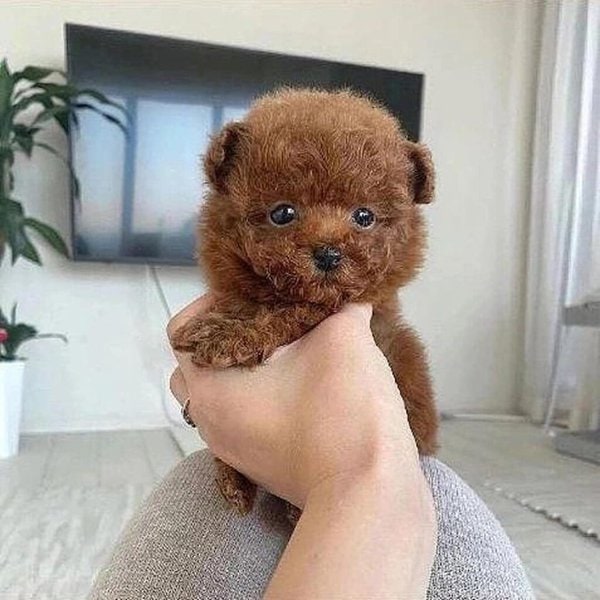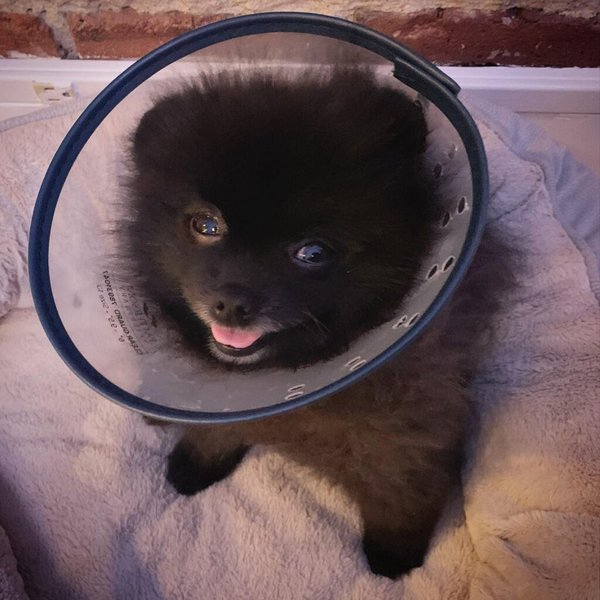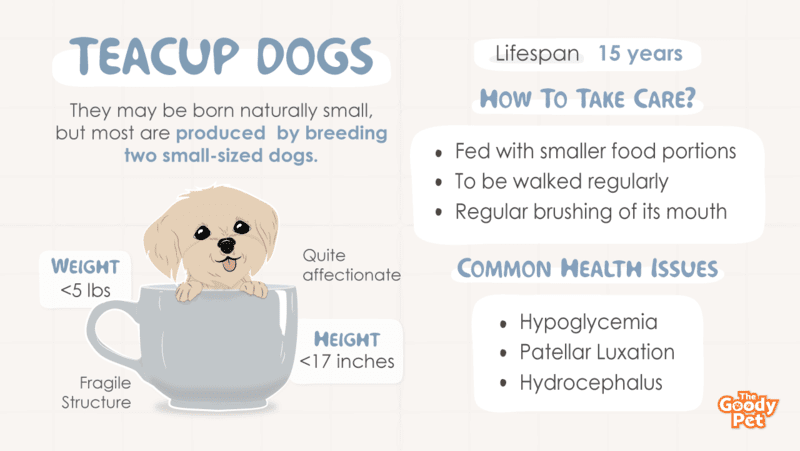You may have once come across someone holding a dog in a purse, and wondered how it is possible for a dog to be born so small. And it is this, coupled with an increase in the popularity of these smaller-than-life Teacup dogs that has facilitated this article. So, what is a Teacup dog?
A Teacup dog is a miniature dog bred to be smaller than the original breed as much as possible. In some cases, Teacup dogs may also be born naturally small, but most are produced as a result of unethically breeding two small-sized dogs. Teacup dogs typically weigh less than 5 lbs and measure less than 17 inches at full maturity.
Due to the breeding practices that give rise to these dogs, along with their unique sizes, caring for Teacup dogs requires a whole lot more attention and dedication. And it is this, coupled with the health issues that constantly plague Teacup dogs, plus their special grooming and feeding needs that make up the bulk of today’s article. However, before you get the urge to splurge the cash on one of these cute, pint-sized doggies, let’s have a look at some reasons why buying a Teacup dog may not be in your best interests.
Why You Should Never Buy A Teacup Puppy?
While there is no doubt that they are little bundles of cuteness, there are several reasons why buying a Teacup puppy is bad for you. Some of these reasons include:
Several Health Issues
One of the major downsides of owning a Teacup puppy is the fact that you’re going to spend most of your time going in and out of the vet’s office as the breed is prone to suffer from various health conditions.
Due to its questionable genetics, the Teacup dog is predisposed to seizures, hydrocephalus, and respiratory and digestive issues. And apart from the aforementioned health conditions, the presence of smaller than normal body organs means the Teacup dog is prone to suffer failure of critical body systems.
Additionally, the small body size makes it extremely difficult for Teacup dogs to regulate their body temperature, hence they have to be strictly monitored at all times. And if you have to rush your Teacup dog to the vet’s, there may not be medical equipment small enough to treat them!

Unethical Breeding Practices
While Teacup puppies may be born naturally as the runt of the litter, they are more often than not, the product of intentionally breeding two Teacups with less desirable qualities. Also, because of the high demand that these Teacup pups are in, certain breeders tend to meet production demands with less ethical methods.
Additionally, Teacup dogs aren’t officially recognized as a dog breed, so you can’t particularly tell what they should look like as puppies. And because most dogs are typically small as puppies, a fraudulent breeder may present a standard dog puppy to you as a teacup puppy.
Fragile Structure
Teacup dogs are born small, and they stay small throughout their lifespan. The average weight for an adult Teacup dog lies between 3 to 5 lbs. And frankly speaking, this minuscule weight is not suited for the hustle and bustle of this world.
It is all too easy for the Teacup doggie to injure itself, and if care is not taken, this pooch can easily be trodden on by unsuspecting humans. Fractures and dislocated joints are a common occurrence with this breed.
How Many Years Do Teacup Dogs Live?
With proper care and attention, Teacup dogs born as the runt of the litter can live for up to 15 years.
However, the prognosis for Teacup puppies produced by unethical breeding of adult Teacups is generally bleak, and they usually don’t live very long before dropping dead.
Common Health Conditions
The inbreeding process required to produce most Teacup dogs, coupled with their abnormally small sizes ensure their lives are filled with a barrage of health conditions. And, more often than not, a Teacup dog will die fast because its body system is not adequately equipped to continue handling core life functions.
That said, some of the common health conditions that plague Teacup dogs during their lifetime include:

Hypoglycemia
Because Teacup dogs have few fat stores, they always need to be fed when due, or else their sugar levels will fall drastically, consequently resulting in hypoglycemia. And without prompt attention, hypoglycemia can kill Teacup dogs.
Observing the symptoms of hypoglycemia in your Teacup dog can be difficult. But you mostly need to watch out for weakness, head tilting, sleepiness, wobbling while walking, and in severe cases, seizures.
The effects of hypoglycemia in Teacup dogs can be countered by keeping your pooch warm and immediately offering it something to eat. If symptoms persist, or in the case of more severe signs such as seizures, you should take your Teacup dog to see the vet immediately.
Hydrocephalus
Hydrocephalus (loosely translated as ‘water on the brain’ in Greek) refers to a condition in Teacup dogs, in which cerebrospinal fluid builds up inside the pooch’s skull. This fluid build-up, in turn, results in brain swelling, irreversible brain damage, and ultimately, death.
Teacup dogs are particularly prone to suffering from hydrocephalus due to their small size, and symptoms of the condition include abnormal walking, seizures, and failure to process basic commands.
Treatment for hydrocephalus in Teacup dogs includes the use of corticosteroids, anti-seizure medications, and in some cases, surgery.
Patellar Luxation
Patellar Luxation in Teacup dogs occurs when the kneecap moves out of its normal position on the femur. Symptoms of Patellar Luxation in Teacups include limping, awkward sitting positions, and skipping while walking. And the condition may result in osteoarthritis or a ruptured cranial cruciate ligament.
Other Health Issues
The conditions listed above are just the tip of the iceberg when it comes to health challenges you can potentially face when raising Teacup dogs. Other health issues common with Teacups include liver shunts, incontinence, bone fractures, joint dislocations, respiratory problems, and so on.
How Do You Take Care Of A Teacup Dog?
Diet
Teacup dogs are a special type, and it is only right that you pay extra attention to their feeding. The ideal meal for a Teacup dog should be rich in fiber and contain lots of protein and veggies.
And if you’re undecided on what to feed your Teacup dog, high-quality dog food like the Pet Plate meal will meet all of your pooch’s nutritional requirements.
And in addition to containing all the essential nutrients for growth, the Pet Plate is very chewable and soft enough for your pooch’s teeth to handle.
Multivitamins will also do your Teacup dog a world of good. And incorporating chewables like the Multivitamin Treats Supplement – Zesty Paws Probiotics into your Teacup’s diet will boost your doggie’s immune system and help with problems of indigestion.
Also, Teacup dogs can only eat and process small amounts of food at a time. Hence, it’s best you break their diets into smaller portions and feed them several times a day. Teacup dogs should be fed at intervals of three to four hours per day!
Exercise
Due to their fragile nature, walking is one of the safest forms of exercise for Teacup dogs, and they need to be walked regularly for appropriate mental stimulation. As is often the case, don’t carry your Teacup puppy around in purses or strollers, as they deserve the opportunity to experience new sights and smells while walking.
And while you may not be able to walk your Teacup for long stretches due to its weak nature, two 10-minute walking sections per day should get the work done.
Rough play should be avoided with Teacup dogs as they can get injured all too easily. And if you must absolutely play with your beloved pooch, a simple game of ‘Fetch’ with the iFetch Interactive Ball Launchers for Dogs should suffice.
The iFetch Launcher comes with mini balls that your Teacup dog can pick with ease, and its automatic ball launching feature means your pooch can play to its heart’s content.
Dental Care
Teacup dogs, as expected, typically have small mouths, and as a result, their teeth aren’t properly spaced; This, in turn, makes your Teacup particularly prone to accumulation of food remains in the mouth and plaque buildup.
However, regular brushing of your Teacup’s mouth, coupled with the use of dental water additives will prevent plaque build-up and ensure your pooch’s breath always smells fresh.
Can Teacup Dogs Be Left Alone? Temperaments Of Teacup Dogs
Generally, Teacup dogs grow to become quite affectionate as they get used to frequent human handling. And as Teacups are usually smaller-sized versions of popular companion dogs, they typically possess qualities of their larger-sized counterparts including loyalty, friendliness, playfulness, and an outgoing personality.
And while the general belief is that Teacup dogs are lap warmers, a good number of these pint-sized doggies would rather spend the day sniffing around the house.
Teacup dogs shouldn’t be left on their own for too long, as they tend to get stressed during their human’s prolonged absence, and this may prove too much for their little canine hearts to handle. Also, there is every possibility of your Teacup dog getting injured, if left unsupervised for a considerable period.
Training
Because most Teacup dog owners tend to neglect the training aspect of their pooches, these little doggies usually bark a lot more than regular-sized canines. Training is essential to curb bad behaviors that your doggie may exhibit, and you can train a Teacup dog by:
- Saying ‘NO’ firmly when you notice your pooch exhibiting inappropriate behavior.
- Take care not to yell or isolate your Teacup dog for bad behavior as this only leads to your doggie getting stressed which can be detrimental to its health.
Also, by reinforcing positive actions with the use of treats and words of praise, Teacup dogs can successfully be potty trained.

Safety
Teacup dogs are very fragile, and it is imperative that you always ensure your home is clear of items that could potentially endanger your furry friend.
Some of the things you can do to keep your Teacup dog safe include:
- Blocking off small holes that your pooch can crawl into.
- Removing objects with which Teacups can potentially climb up to higher surfaces – jumping off from medium to high-level heights can be fatal for Teacups.
- Keep the floor clear of small items that can choke your Teacup doggie.
- Never leave your Teacups to climb or descend stairs alone.
- Thoroughly inspect all furniture before sitting or lying down – your Teacup dog could be cuddled up in your bed or on your couch.
- Teacups are prone to predators such as hawks, hence do not leave your pooch alone outside, unsupervised.
Are Teacup Dogs Hypoallergenic? Grooming Tips For Teacup Dogs
Shedding
Whether or not a Teacup dog will shed is largely dependent on the behavioral pattern of its large-sized counterparts. If the larger-sized version of a dog breed tends to shed a lot, then you can expect the Teacup version to follow suit.
However, considering the fact that Teacup dogs are significantly smaller in size, the amount of hair that falls out during shedding is far lesser than with big dogs, and is often negligible.
Also, due to their relatively small sizes and lesser shedding, Teacup dogs are mostly hypoallergenic. And with a proper vacuum cleaning solution like the iRobot Roomba i3+, Teacups are perfect for those with dog allergies.
The iRobot boasts powerful allergen locks that are quite effective at cleaning dander, and its power-lifting suction can pick up the tiniest of Teacup hairs.
Brushing
Frequent brushing is recommended for Teacup dogs with longer fur, as this helps keep their hair from becoming matted. For Teacups with shorter hair, the brushing frequency is significantly reduced, but you should occasionally brush through their coats to help maintain a polished look.
If you’re to brush your Teacup’s coat, I’d recommend you do so with a brushing tool with soft bristles or harmless teeth like the FURminator Undercoat Tool. In addition to its soft bristles, this tool comes with an ergonomic handle that makes brushing your Teacup dog a breeze.
Bathing
Doggies typically don’t need bathing every day, and with Teacup dogs, the need to bathe them is significantly reduced.
When you eventually have to bathe your Teacup dog, you should do so in a bath with warm water that’s only a couple of inches tall, and with mild dog shampoo like the Mighty Petz 2-In-1 Oatmeal Dog Shampoo And Conditioner.
The sweet-smelling Mighty Petz shampoo helps keep your Teacup’s skin moisturized and its all-natural formulation reduces the risk of allergic reactions.
Additionally, you should put small cotton swabs in your Teacup dog’s ears during bath time to prevent water from getting into your doggie’s ears. By doing this, you’re reducing the risk of ear infections in your Teacup dog.
Related Questions
How Much Does A Teacup Puppies Cost? Due to the extreme care required to raise them, coupled with the unique breeding methods, Teacup puppies are quite expensive. And it’ll cost you between $750 to $4,000 to acquire any of the numerous teacup breeds. The amount you’d ultimately spend to purchase a teacup puppy ultimately depends on factors such as the breeder you’re buying from, the teacup’s bloodline, and the pup’s general health.
What Is The Best Teacup Puppy To Get? The best Teacup Puppy to get is one that is born naturally as the smallest of the litter, and not as a result of unethical breeding practices. If it’s absolutely necessary for you to own a Teacup Puppy, you should buy from reputable breeders only. And the Teacup Chihuahua, which is arguably the smallest Teacup breed, is a great choice.
Can Teacup Dogs Have Babies? Yes, Teacup Dogs can have babies. However, due to the mother’s small size, carrying a pregnancy is particularly difficult for Teacups. And when the time comes to deliver Teacup puppies, there is a high possibility that complications will arise; This can, in turn, be extremely dangerous for both the mother and the puppies.





